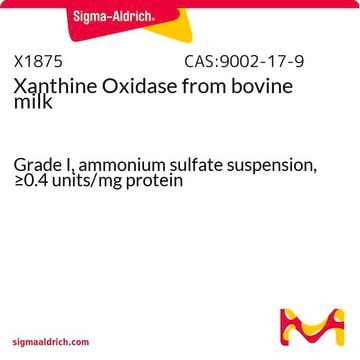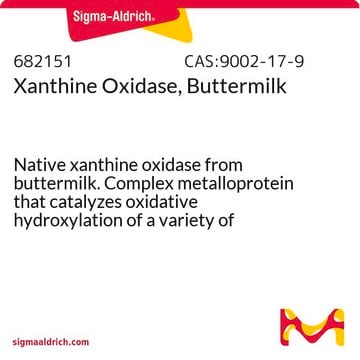Products may be shipped at a different temperature than the recommended long-term storage temperature. If the product quality is sensitive to short-term exposure to conditions other than the recommended long-term storage, it will be shipped on wet or dry-ice. If the product quality is NOT affected by short-term exposure to conditions other than the recommended long-term storage, it will be shipped at ambient temperature. As shipping routes are configured for minimum transit times, shipping at ambient temperature helps control shipping costs for our customers. For more information, please refer to the Storage and Transport Conditions document: https://www.sigmaaldrich.com/deepweb/assets/sigmaaldrich/marketing/global/documents/316/622/storage-transport-conditions-mk.pdf
Kluczowe dokumenty
MAK078
Xanthine Oxidase Activity Assay Kit
sufficient for 100 colorimetric or fluorometric tests
Synonim(y):
XO Activity Assay Kit
About This Item
Polecane produkty
zastosowanie
sufficient for 100 colorimetric or fluorometric tests
metoda wykrywania
colorimetric
fluorometric
powiązane choroby
rheumatological diseases; gastrointestinal diseases; cardiovascular diseases
temp. przechowywania
−20°C
informacje o genach
human ... XDH(7498)
mouse ... XDH(22436)
rat ... XDH(497811)
Opis ogólny
Zastosowanie
Przydatność
Zasada
zastąpiony przez
Kod klasy składowania
10 - Combustible liquids
Wybierz jedną z najnowszych wersji:
Certyfikaty analizy (CoA)
Nie widzisz odpowiedniej wersji?
Jeśli potrzebujesz konkretnej wersji, możesz wyszukać konkretny certyfikat według numeru partii lub serii.
Masz już ten produkt?
Dokumenty związane z niedawno zakupionymi produktami zostały zamieszczone w Bibliotece dokumentów.
Klienci oglądali również te produkty
-
How is shipping temperature determined? And how is it related to the product storage temperature?
1 answer-
Helpful?
-
-
How can I determine the shelf life / expiration / retest date of this product?
1 answer-
If this product has an expiration or retest date, it will be shown on the Certificate of Analysis (COA, CofA). If there is no retest or expiration date listed on the product's COA, we do not have suitable stability data to determine a shelf life. For these products, the only date on the COA will be the release date; a retest, expiration, or use-by-date will not be displayed.
For all products, we recommend handling per defined conditions as printed in our product literature and website product descriptions. We recommend that products should be routinely inspected by customers to ensure they perform as expected.
For products without retest or expiration dates, our standard warranty of 1 year from the date of shipment is applicable.
For more information, please refer to the Product Dating Information document: https://www.sigmaaldrich.com/deepweb/assets/sigmaaldrich/marketing/global/documents/449/386/product-dating-information-mk.pdfHelpful?
-
-
Does the kit allow the use of cell pellets that have been frozen at -80°C, or do the samples need to be fresh, considering that the cells should be rapidly homogenized with the assay buffer?
1 answer-
The cell pellet can be stored at -80°C with a small amount of PBS, avoiding storage with culture medium. Upon thawing, it's recommended to wash the cells once with PBS and then remove the PBS. Following this step, the assay buffer should be used for extraction according to the kit instructions. It's important to avoid multiple freeze-thaw cycles. However, the supplier does not specify the maximum time frozen cells will remain stable for assay.
Helpful?
-
Active Filters
Nasz zespół naukowców ma doświadczenie we wszystkich obszarach badań, w tym w naukach przyrodniczych, materiałoznawstwie, syntezie chemicznej, chromatografii, analityce i wielu innych dziedzinach.
Skontaktuj się z zespołem ds. pomocy technicznej







